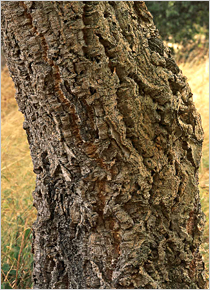DK Science: Trees
These tall, seed-producing plants live for many years and do not die in winter. Trees have a single woody stem, called a trunk, which thickens as they get older and supports their increasing bulk. In some parts of the world, trees grow together in FORESTS. Trees are divided into two main groups: conifers and broad-leaved trees. Many broad-leaved trees are DECIDUOUS, which means they lose their leaves in autumn. Conifers are mainly EVERGREEN TREES and they keep their leaves throughout the year.
Tree trunks are made up of different layers of cells. On the outside is a protective layer called bark. Just beneath the bark is a thin layer of phloem cells, which carry food from the leaves to the rest of the tree. Below the phloem is another thin layer of cells, the cambium, which constantly divide and make the trunk wider. Beneath them, the sapwood draws up water and minerals from the roots.

A tree’s bark is its skin. It shields the living wood inside, preventing it from drying out and protecting it from extreme cold and heat. Tiny slits in the bark, called lenticels, allow oxygen to enter the trunk and carbon dioxide to leave it. Different tree species have different bark textures. The bark of oak is cracked and rough. Beech bark is very thin and delicate. Birch bark is relatively smooth.
Almost a third of the world’s land surface is covered by forests, which are areas with dense tree cover. Forests differ according to the local climate – tropical, temperate, or boreal. Rainforests, thrive in warm and wet climates. Here there may be more than 200 tree species in one hectare (2 1/2 acres) of land. The majority of trees in temperate forests are deciduous, such as oak and beech. In cold, northern regions, boreal forests contain hardy coniferous trees.
Rainforests grow in distinct layers, each with its own plant and animal species. Life is richest in the canopy, which contains most of the leaves, flowers, and fruit. A few very tall trees grow through this into the emergent layer. Beneath the canopy is an understorey of smaller trees and, below that, a shrub layer of big-leaved plants that can survive in low-light conditions. At the very bottom is the dark forest floor, where plants are smaller and fewer.
Tree roots spread out in a huge network under the ground. This network is often as big as the crown of branches above. A tree’s larger roots anchor it firmly in the ground. Most of the delicate feeding roots are nearer the surface. These are covered in root hairs which draw in water and nutrients from the soil.
Each leaf on an evergreen tree may last for years and only falls when it is ready to be replaced. As a result, these trees remain covered with leaves throughout harsh cold or dry seasons. Most conifers, such as pine trees, keep their leaves for between two and four years. In places where there is little seasonal change, such as the wet tropics, many other types of plant are also evergreen.
The leaves of many evergreen trees contain resins. These heal breaks in the surface and also prevent the leaves from freezing. The antifreeze properties of pine resins enables the cells in their needles to survive throughout the winter, even when they are completely covered with snow or ice.
Trees that lose their leaves in the autumn are called deciduous trees. They grow in temperate regions – places that have warm summers and cold or cool winters. In autumn, temperatures start to fall and there are fewer hours of daylight for photosynthesis. To conserve energy during winter the trees shed their leaves and stop growing. This also helps them save water, which would otherwise evaporate from the surface of their leaves.

The leaves of some deciduous trees turn brilliant colours just before they fall. For example, maple leaves change from green to yellow then turn orange and red. This colour change happens because the chlorophyll that made the leaves green is broken down in autumn and used by the tree. Other pigments that were previously hidden beneath the chlorophyll are then revealed.
